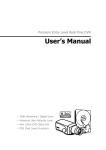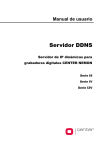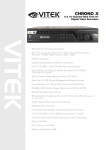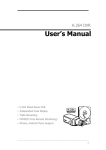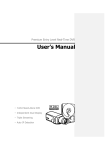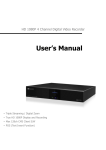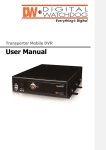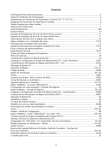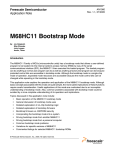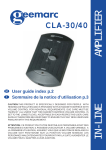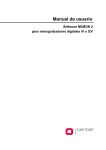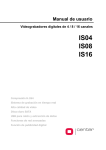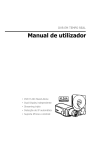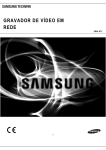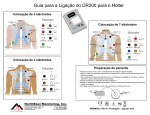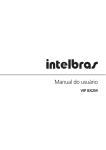Download User׳s Manual - CNB Technology.
Transcript
Performance Series Real-Time DVR User’s Manual ▪ H.264 Stand-Alone DVR ▪ Independent Dual Display ▪ Triple Streaming ▪ Auto IP Detection ▪ iPhone, Android Phone Support Preface Thank you for being a user of the world's best digital video recorder (DVR), and the leading Digital Video Surveillance System. For effective usage, please read this manual carefully. For future reference, please keep this manual handy. Copyright/Authentication/Trademark/Limited Warranty Copyright This manual is produced under copyright law. None of its contents may be copied or duplicated without prior approval. Copyright 2009~ Authentication CE, FCC, KCC Trademark Ethernet(TM) is the trademark of Xerox Corporation. Microsoft(TM), MS-DOS(TM), Windows(TM logo), Windows(TM) and Windows NT(TM) are the trademarks of Microsoft Corporation, used in the United States and elsewhere. Limited Warranty • The manufacturer, importer and agent shall not be responsible for accidental damage (including injury) and other damage caused by inappropriate use or operation of this product. • The information in this manual is prepared based on the current specifications for the product. The manufacturer is currently adding new functions and will continue to upgrade the product with new technology. All specifications may be changed without notice to individual users. Cautions We strongly recommend that users read all safety cautions carefully before operating the product in order to operate the product appropriately. Since the indicated cautions contain critical safety information, they must be fully complied with. The cautions are categorized into Danger, Warning, Caution and Important. Risk of death or serious injury. This is the highest priority danger warning. Risk of serious or lesser degree of injury. May also cause damage to the product or to property. Risk of minor injury or damage. Requirements or limitations regarding operation. Users are recommended to read the relevant details carefully so as to operate the product properly and without harm. The above cautions indicate the degree of damage that may occur due to inappropriate use of the system. 1 Risk of death or serious injury. This is the highest priority danger warning. • RISK OF EXPLOSION IF BATTERY IS REPLACED BY INCORRECT TYPE. DISPOSE OF USED BATTERY ACCORDING TO THE INSTRCTIONS. • THIS EQUIPMENT IS FOR INDOOR USE AND ALL WIRINGS AND CABLINGS SHOULD BE LIMITED TO INSIDE OF THE BUILDING. • Please connect the power cord only to the type of AC outlet indicated in the manual or product specification. If connected to other types of power outlet, fire or electric shock may occur. • Do not expose the product to moisture or dampness. Doing so may result fire or electric shock. • Do not place heavy objects on top of the power cord. Damage to the power cord may result in fire or electric shock. • Do not place containers with liquid or small metal objects on top of the product. Liquid or small metal objects getting into the unit may lead to fire or electric shock. • Do not score, bend, twist, pull or heat the power cord. Damage to the power cord may lead to fire or electric shock. • Do not remove the top casing of the product. Doing so may result in electric shock. If internal examination and maintenance are deemed necessary, contact the authorized system vendors or installers. • Do not modify the product in any way. Doing so may lead to fire or electric shock. • In case of lightning, immediately turn off the power switch and remove the power cord from the power outlet. Failure to do so may result in fire or electric shock. • Please use only the power cord supplied with the product. Use of other power cords may result in fire or electric shock. • In case of smoke, smell or noise, immediately turn off the power switch and remove the power cord from the power outlet. Continued operation of the product may result in fire or electric shock. Request a maintenance service from the authorized system vendors or installers. • If the product is dropped or damaged, turn off the power switch and remove the power cord from the power outlet. Continued operation of the product may result in fire or electric shock. Users should request a maintenance service from the authorized system vendors or installers. • Do not touch the product with wet hands. Doing so may result in electric shock. Risk of serious or lesser degree of injury. May also cause damage to the product or to property. • Do not leave the power cord or other cables in passageways. Passers-by may trip and fall. • Avoid contact with water or beverages. It may result in damage that cannot be repaired. • In case of lightning, immediately turn off the power switch and remove the power cord from the power outlet. The product may otherwise be damaged. • Excessive current from the product and the camera may result in an electric shock. Connect the power cord only to an appropriate power source when the product is disconnected from its own power supply. 2 Risk of minor injury or damage. • If a foreign substance is stuck to the product, remove it using a soft cloth or tissue. Do not use chemical agents (thinner, solvent, etc.) to remove the substance. • Do not operate or store the product in the following places. - An area that is either too cold or too hot - An area of high humidity, in front of an air-conditioner, or in places subject to sudden temperature changes - An area with excessive dust - Areas where heat from the product cannot be dissipated through both of the product's side ventilation openings • Do not place credit cards/telephone cards/bank account books/tickets and other objects with magnetic properties near the product. • Static electricity may cause damage to the internal parts of the product. Please remove static electricity from your body before touching the rear panel and internal electronic parts of the product. • If this product is damaged beyond repair or reaches its maximum service life, dispose of it in compliance with local laws and regulations regarding to the disposal of lead and plastic waste. Requirements or limitations regarding operation. Users are recommended to read the relevant details carefully so as to operate the product properly without any injury or damage. • The product may not work properly if the power source is unstable or if an electric shock occurs. Make sure to use the correctly rated power. • The product is designed to be safe against electric power failures; however, damage may occur at a power failure. Current data may be damaged or not be recorded properly. Make sure to use an Uninterruptible Power Supply (UPS). • Since the product is designed to record video data on a hard disk, an error in the hard disk or other miscellaneous errors might prevent the product from recording properly. Periodic maintenance is required for proper operation of the product. • The product is designed for users to configure their own interface. However, a user configuration error could lead to an operation failure. This product should be set up by certified installers only. • Since the product is connected - and tightly coupled - to exterior accessories (camera, sensor, LAN, Hard Disk, etc.), there is a risk of malfunction from external causes. Make sure to have certified installers do regular maintenance on all devices in the system. • Use the rack mounting handle provided with the product for installation. • In this product, 1 Kbyte equals 1,024 bytes, 1 Mbyte equals 1,048,576 bytes and 1 Gbyte equals 1,073,700,000 bytes. 3 Contents Preface ............................................................................................... 1 Contents ............................................................................................. 4 Chapter 1. Introduction ..................................................................... 7 1. The System ......................................................................................................... 7 2. General Features ................................................................................................ 7 3. Specification ....................................................................................................... 8 Chapter 2. System Installation ........................................................ 10 1. Package Contents ............................................................................................. 10 2. Connecting Devices .......................................................................................... 11 2-1. 4 Channel Premium DVR ................................................................................... 11 2-2. 8/16 Channel Premium DVR .............................................................................. 14 3. Cautions............................................................................................................ 16 Chapter 3. Using DVR ....................................................................... 17 1. Basic Operation ................................................................................................ 17 1-1. Front Panel & IR Remote Controller ................................................................... 17 1-2. Turning on the System ...................................................................................... 17 1-3. Menu Bar ......................................................................................................... 18 1-4. Display Icons ................................................................................................... 18 1-5. User or Admin Login ......................................................................................... 20 1-6. The Main Menu ................................................................................................ 21 1-7. Contextual Menu .............................................................................................. 22 2. DVR Configuration ............................................................................................ 23 2-1. SYSTEM ........................................................................................................... 23 2-1-1. MENU > SYSTEM > Information .............................................................. 23 2-1-2. MENU > SYSTEM > Date & Time ............................................................. 24 2-1-3. MENU > SYSTEM > User......................................................................... 24 2-1-4. MENU > SYSTEM > Quick Setup .............................................................. 26 2-1-5. MENU > SYSTEM > System Log .............................................................. 26 2-2. DEVICE............................................................................................................ 27 2-2-1. MENU > DEVICE > Camera ..................................................................... 27 2-2-2. MENU > DEVICE > Audio ........................................................................ 28 2-2-3. MENU > DEVICE > Alarm........................................................................ 28 2-2-4. MENU > DEVICE > Keyboard .................................................................. 29 2-2-5. MENU > DEVICE > RS232 & RS485 ......................................................... 29 2-3. DISPLAY .......................................................................................................... 30 2-3-1. MENU > DISPLAY > Display .................................................................... 30 2-3-2. MENU > DISPLAY > VGA ........................................................................ 30 2-3-3. MENU > DISPLAY > CVBS ....................................................................... 31 2-3-4. MENU > DISPLAY > Digital Signage ......................................................... 32 2-4. RECORD .......................................................................................................... 33 2-4-1. MENU > RECORD > Storage ................................................................... 33 2-4-2. MENU > RECORD > Record..................................................................... 33 2-4-3. MENU > RECORD > Utilities .................................................................... 35 2-5. NETWORK ....................................................................................................... 36 2-5-1. MENU > NETWORK > Address ................................................................ 36 2-5-2. MENU > NETWORK > DDNS ................................................................... 37 2-5-3. MENU > NETWORK > Notification ........................................................... 37 4 2-5-4. MENU > NETWORK > Transmission ......................................................... 38 2-6. EVENT ............................................................................................................. 39 2-6-1. MENU > EVENT > Sensor ....................................................................... 39 2-6-2. MENU > EVENT > Motion ....................................................................... 40 2-6-3. MENU > EVENT > Video Loss .................................................................. 43 2-6-4. MENU > EVENT > Text-In ....................................................................... 44 2-6-5. MENU > EVENT > System ....................................................................... 46 3. Playback ........................................................................................................... 47 3-1. Go to Time....................................................................................................... 49 3-2. Calendar Search ............................................................................................... 49 3-3. Event Search .................................................................................................... 49 3-4. Text-In Search.................................................................................................. 50 3-5. Backup Data Playback ...................................................................................... 51 3-6. Playback Control .............................................................................................. 52 4. Backup .............................................................................................................. 53 4-1. Backup ............................................................................................................ 53 4-2. Instant Backup ................................................................................................. 54 4-3. Clip Maker........................................................................................................ 54 Chapter 4. Remote Software ........................................................... 55 1. Using Remote Software .................................................................................... 55 1-1. Starting the Software........................................................................................ 55 1-2. Site Set Up ...................................................................................................... 57 1-3. Favorite Set Up ................................................................................................ 60 1-3. Site List Panel .................................................................................................. 62 1-4. Tool Panel ........................................................................................................ 63 1-4-1. DVR Status............................................................................................. 63 1-4-2. PTZ ....................................................................................................... 63 1-4-3. TEXT-IN ................................................................................................. 64 1-4-4. GPS ....................................................................................................... 64 2. Remote Playback .............................................................................................. 65 2-1. Calendar Search ............................................................................................... 65 2-2. Event Search .................................................................................................... 66 2-3. Text-In Search.................................................................................................. 67 2-4. Saving the recorded data .................................................................................. 68 2-5. Play Backup Data ............................................................................................. 69 2-6. Play Independent HDD Data on PC .................................................................... 70 3. Setup ................................................................................................................ 71 3-1. Remote Software Setup .................................................................................... 71 3-2. Remote DVR Setup ........................................................................................... 75 3-3. Remote Upgrade .............................................................................................. 76 4. Callback ............................................................................................................ 77 Appendix A. Remote Access Using I.E. ............................................ 79 Appendix B. How to set DDNS using router ..................................... 83 Appendix C. Digital Signage Maker .................................................. 89 1. How to use Digital Signage Maker ........................................................................ 90 Appendix D. PFRM Instructions ....................................................... 92 1. Outline ............................................................................................................... 92 2. How to connect ................................................................................................... 93 Appendix E. NEMON Network Archiver Instructions ....................... 95 1. Outline ............................................................................................................... 95 5 2. Feature ............................................................................................................... 95 3. How to use Network Archiver ............................................................................... 96 4. Set Up .............................................................................................................. 100 5. Reference ......................................................................................................... 106 COMPLIANCE NOTICE OF FCC: ........................................................................... 107 WEEE (Waste Electrical & Electronic Equipment)............................................... 107 ROHS Compliance ............................................................................................... 107 6 Chapter 1. Introduction 1. The System This product is targeted towards the expanding DVR market. As the market is expanding from Professional to Consumer and into wider sectors, both price and feature oriented products are highly on demand across different market sectors. This product is designed to fulfill these various aspects of different market needs. This highly affordable, reliable, and usable DVR series is to fulfill basic DVR requirements and the most satisfactions. 2. General Features • True H.264 Standard Video Compression • Embedded Linux System to give you the Ultimate Reliability • Dedicated DB Structure for Stability • Various Recording Resolution D1/Half D1/CIF • CMS (Central Monitoring System) • Easy Setup same like DVR GUI in CMS • Web Monitoring, Searching and Setup • Own Media Player for Backup Playback • Two USB Port for Mouse operation, Multi USB Hub and Backup • Up to Two SATA HDD and No Limitation of Capacity • Two- Way Audio • Multiple DVRs can be operated with One Keyboard Controller • Text-In & Relay Output Support • Real Time Recording and Multi Ch. Playback • Triple Streaming / Digital Zoom • iPhone, Android Phone Support • Independent Dual Display Dual Display allows user to use both VGA and CVBS outputs at the same time with different display options. Two different individual display modes can be set on each monitor output. Two different display mode (Live Monitoring on one monitor and Playback on the other) can be displayed and controlled at the same time. This function will provide high flexibility and efficiency for monitoring options for the users. Note: This manual covers the 4-channel, 8-channel and 16-channel DVRs. The DVRs are identical except for the number of cameras, audio inputs and alarms. The GUI illustrations and descriptions in this manual are based on the 4 channel model. 7 3. Specification Model 4 Channel Performance DVR Video Audio Device Display In 4 BNC (without Loop-out) Out 1 VGA, 1 CVBS (Dual Display) In 4 RCA (Line-In) Out 1 RCA (Line-Out) Sensor In 4 TTL (3+Emergency) Alarm Out 2 Open Collector Output I/O Interface RS232, RS485, USB x 2 Speed Real Time Resolution 720 x 480 (NTSC) Split Screen 1, 4, PIP, Digital Zoom Compression H.264 Codec Speed / Resolution 120fps@Half D1(NTSC) 60fps@D1(NTSC) Picture Quality Very High, High, Standard, Low Mode Time-lapse, Event, Time & Event, Emergency (Panic) Display 1, 4, Digital Zoom Search Mode Calendar Search, Event Search, Text-In Search, Go to Time 120fps@CIF(NTSC) Recording Playback Playback Mode Interface Network Ethernet (10/100 Base) Protocol TCP/IP, HTTP, DHCP, ADSL(PPPoE), RTP/RTSP Application Live, Playback, Setup, Notification (Callback, E-Mail) Web Browse Internet Explorer 7 or higher Mobile Support iPhone, Android Phone (Real Streaming) Storage 2 x SATA HDD Backup External HDD(USB), External USB Memory Control 8 Multi Channel Normal & Reverse Play, RW & FF ( x2, x4, x8, x16, x32), Frame to Frame, Pause Front Panel Button, USB Mouse port, IR Remote Controller, Joystick Controller port OSD Graphic User Interface (Multilingual) Approval FCC, CE, KCC ROHS ROHS Compliance Power Consumption DC12V, 3.33A (40W) Operating Temperature 41°F~104°F Operating Humidity 0%~80% / non-condensing Dimension 13.39(W)x2.64(H)x10.43(D)inch Weight 4.4lbs (without HDD) Model 8 Channel Performance DVR In Video Display 1 VGA, 1 CVBS (Dual Display) In 8 RCA (Line in) – Option* Out 1 RCA (Line Out) Sensor In 4 TTL (3+Emergency) Alarm Out 2 Open Collector Output I/O Interface RS232, RS485, USB x 2 Speed Real Time Resolution 720 x 480 (NTSC) Split Screen Speed / Resolution Network Digital Zoom H.264 Codec 240fps@CIF(NTSC) 480fps@CIF(NTSC) 240fps@Half D1(NTSC) 240fps@Half D1(NTSC) 120fps@D1(NTSC) 120fps@D1(NTSC) Picture Quality Very High, High, Standard, Low Mode Time-lapse, Event, Time & Event, Emergency (Panic) Display Playback 1,4,6,8,9,13,16,PIP, 1,4,6,9,PIP,Digital Zoom Compression Recording 16 BNC (Loop-out option*) Out Audio Device 8 BNC (Loop-out option*) 16 Channel Performance DVR 1, 4, 6, 9, Digital Zoom 1,4,6,8,9,13,16,Digital Zoom Search Mode Calendar Search, Event Search, Text-In Search, Go to Time Playback Mode Multi Channel Normal & Reverse Play, RW & FF ( x2, x4, x8, x16, x32), Frame to Frame, Pause Interface Ethernet (10/100 Base) Protocol TCP/IP, HTTP, DHCP, ADSL(PPPoE), RTP/RTSP Application Live, Playback, Setup, Notification (Callback, E-Mail) Web Browse Internet Explorer 7 or higher Mobile Support iPhone, Android Phone (Real Streaming) Storage 2 x SATA HDD Backup External HDD(USB), External USB Memory Control Front Panel Button, USB Mouse port, IR Remote Controller, Joystick Controller port OSD Graphic User Interface (Multilingual) Approval FCC, CE, KCC ROHS ROHS Compliance Power Consumption DC12V, 3.33 (40W) Operating Temperature 41°F~104°F Operating Humidity 0%~80% / non-condensing Dimension 13.39(W)x2.64(H)x10.43(D)inch Weight 4.4lb (without HDD) * Requires optional accessory connector(s). Please ask about this to your supplier. 9 Chapter 2. System Installation 1. Package Contents The following components are included in the product packaging: DVR Unit DC Adaptor Power Cord Remote Controller Quick Guide Customer Card Note: Please download Users‟ Guide and Remote Client S/W from the address written on the customer card. 10 2. Connecting Devices 2-1. 4 Channel Premium DVR The rear panel of the 4 channel performance DVR looks like the following: • Front USB: On the front panel, two USB ports are provided to connect external devices like HDD and Flash memory for Backup and System upgrade. A USB mouse can only be connected to the USB port dedicated for mouse. Video Input Connect the coaxial cables from the cameras to the BNC video connectors. Audio Input The 4 channel DVR can record audio up to 4 sources. Connect the audio sources to the Audio-In RCA connectors. All channels need external preamplifiers. It is the user's responsibility to determine if local laws and regulations permit recording of audio or not. Audio Out You will need to connect a speaker and an amplifier to this output. The DVR does not have a built in amplifier. 11 Video Output Connect the monitors to VGA or CVBS out connector. Dual Display allows user to use both VGA and CVBS outputs at the same time with different display options. Two different and individual display modes such, as live on one and playback on the other, can be set on each monitor output. This function will provide such high flexibility and efficiency for monitoring options. Note: VGA Monitor is set as a main monitor when system boots up. To move the control to another monitor (CVBS), please use one of the following control options. 1. Press and Hold Display button for 3 seconds. 2. Click 2 mouse buttons at the same time. 3. Choose “Move Display Focus” on the contextual menu on GUI. Please refer to following list for independent dual display/control options. VGA Monitor CVBS Monitor LIVE (O) LIVE PLAYBACK (O) PTZ (O) DISIGTAL SIGNAGE (O) LIVE (O) PLAYBACK PLAYBACK (X) PTZ (O) DISIGTAL SIGNAGE (X) LIVE (O) PTZ PLAYBACK (O) PTZ (O) DISIGTAL SIGNAGE (O) LIVE (O) DIGITAL SIGNAGE PLAYBACK (X) PTZ (O) DISIGTAL SIGNAGE (O) 12 RS485/ALARM/SENSOR The RS485 connector can be used to control PTZ cameras. The DVR can also be controlled remotely by an RS-485 control keyboard through this port. 2 alarm output connectors are provided to connect external alarms such as sirens or lights. Alarm output connectors are Open-collector output signals. 3 sensor input and 1 emergency sensor input connectors are provided to connect the DVR to external alarm sensor devices. This input will be processed ad Alarm events by the DVR. The emergency sensor is designed for Emergency recording only. The DVR will do the Emergency record as per the configurations when this port is triggered. An RS-232C connector is provided to connect the DVR to an ATM or POS machine for Text-In function. To make connections on the terminal block, press and hold the button and insert the wire in the hole below the button. ETC • Network: Connect a Cat5 cable with an RJ-45 connector to the DVR‟s network port for monitoring, playback, and setup from a remote site. See Chapter 3-2. DVR Configuration for configuring the Network connections. • Reset: The DVR has a Reset switch that will only be used to return all the settings to the original factory settings. To reset the unit, turn the DVR off first. Turn the DVR on while poking a straightened paperclip in the reset hole. Hold the switch while the DVR is initializing. • Power Connector: Connect adapter cable to the power connector on the rear panel. (DC12V, 3.33A) Input AC power to the adapter. (free voltage from 100V to 240V, 50/60Hz) 13 2-2. 8/16 Channel Premium DVR The rear panels of the 6/18 channel Performance DVR look like the following: [8 Channel Premium Model] [16 Channel Premium Model] • Front USB: On the front panel, two USB ports are provided to connect external devices like HDD and Flash memory for Backup and System upgrade. A USB mouse can only be connected to the USB port dedicated for mouse. Video Input Connect the coaxial cables from the cameras to the BNC video connectors. Loop-Through Video Connect the coaxial cables from the Loop BNC connector (Optional accessory) to another device. Note: To use Loop option, additional Loop BNC connector (Optional accessory) is needed. Please contact your supplier about this. Audio Input The DVR can record audio up to 8 sources. Connect the audio sources to the Audio-In Multi-connectors (Optional Accessory). All channels need external pre-amplifiers. It is the user's responsibility to abide to local laws and regulations regarding to recording audio. 14 Video Output Connect the monitors to VGA or CVBS out connector. Dual Display allows user to use both VGA and CVBS outputs at the same time with different display options. Two different and individual display modes such, as live on one and playback on the other, can be set on each monitor output. This function will provide such high flexibility and efficiency for monitoring options. Note: VGA Monitor is set as a main monitor when system boots up. To move the control to another monitor (CVBS), please use one of the following control options. 1. Press and Hold Display button for 3 seconds. 2. Click 2 mouse buttons at the same time. 3. Choose “Move Display Focus” on the contextual menu on GUI. RS485/ALARM/SENSOR The RS485 connector can be used to control PTZ cameras. The DVR can also be controlled remotely by an RS-485 control keyboard through this port. 2 alarm output connectors are provided to connect external alarms such as sirens or lights. Alarm output connectors are Open-collector output signals. 3 sensor input and 1 emergency sensor input connectors are provided to connect the DVR to external alarm sensor devices. This input will be processed ad Alarm events by the DVR. The emergency sensor is designed for Emergency recording only. The DVR will do the Emergency record as per the configurations when this port is triggered. An RS-232C connector is provided to connect the DVR to an ATM or POS machine for Text-In function. To make connections on the terminal block, press and hold the button and insert the wire in the hole below the button. ETC • Network: Connect a Cat5 cable with an RJ-45 connector to the DVR‟s network port for monitoring, playback, and setup from a remote site. See Chapter 3-2. DVR Configuration for configuring the Network connections. • Reset: The DVR has a Reset switch that will only be used to return all the settings to the original factory settings. To reset the unit, turn the DVR off first. Turn the DVR on while poking a straightened paperclip in the reset hole. Hold the switch while the DVR is initializing. 15 • Power Connector: Connect adapter cable to the power connector on the rear panel. (DC12V, 3.33A) Input AC power to the adapter. (free voltage from 100V to 240V, 50/60Hz) 3. Cautions • Avoid installing the product in hot places or near the heat generator. (It may cause fire.) • Do not put vase, flowerpot, cup, cosmetics, drug, or anything that contains liquid on the product. (It may cause fire or electric shock, or they may fall and cause injury) • Do not insert or drop any metal object (coin, hair pin) or flammable object (match, paper) into the air vent. (It may cause fire or electric shock) • Do not put a heavy object on the product. (It may damage the product or may fall and cause injury.) • Secure the power plug and do not move it around. (It may cause fire.) • Unplug the power plug when there are thunders and lightening. (It may cause fire.) • To clean the product, wipe the surface with a dry towel. Using chemical or cleaner may change the color or peel off the paint. • Do not plug multiple units to a single outlet. (It may cause electric shock.) If there is smoke or smell, stop the operation immediately. Turn the power off and unplug it, and contact our service center. (it may cause fire or electric shock.) • When unplugging the cord, do not strain the cord too much. (A cord can be damaged and may cause fire or electric shock.) • Do not plug or unplug with wet hands. (It may cause electric shock.) • Do not twist the power cord. (It may cause fire or electric shock.) • Use the adapter supplied or specified. (An adapter that does not match the power rating may cause fire or electric shock.) • Do not install the product in the place that is exposed to rain, wind, or water drop. (It may cause fire, electric shock, or malfunction.) • Keep away from fire. (It may cause an explosion or overheating.) • Do not disassemble or alter the product on your own. (It may cause malfunction or electric shock.) • Keep away from flammable materials such as flammable spray. (It may cause fire.) • Do not install the product in a dirty place. (Too much dirt may cause fire.) • Do not install the product on an unstable places like shaking or inclined table. (It may fall and cause injury.) • Do not put heavy objects on power cord, or do not put the power cord underneath the product. (It may cause fire or electric shock.) • Do not use multiple extension cords to power up the device. (The extension cords may heat up and cause fire.) • When there is a dirt or debris on the metal pin of power cord or the power outlet, clean it before using. (It may cause fire.) • Do not use damaged power cord or plug. Do not excessively bend, twist, or pull the cord. Do not place the cord on a pathway or near heat. Do not use a loose power outlet. (It may cause fire or electric shock.) • Do not drop the product or apply a physical shock. (It may injure people or cause malfunction.) • Do not touch the power adaptor or signal controller. (It may cause electric shock.) • Do not block the cooling fan. (It may cause fire.) • An improper type batteries may explode. • Dispose of used batteries safely. • Do not let the children play with the batteries. Keep the product away from the children. (If a child put the battery in his mouth, contact a doctor right away.) 16 Chapter 3. Using DVR 1. Basic Operation 1-1. Front Panel & IR Remote Controller The DVR should be correctly installed before proceeding. The location and shape of the buttons and function keys may vary depending on the DVR model. Only the most commonly used functions are linked to the buttons on the front panel. Control Description USB Port Two USB ports are located on the front panel. Pressing camera buttons and Enter button will display the Camera Buttons (1~0) MENU / EXIT Button selected camera full screen. Buttons are also used to enter passwords. Opens up the Setup Menu. The User will need to enter the authorized password to assess the menu. In Playback mode, MENU button opens the Playback Menu. DISPLAY Button SEQUENCE Button Changes the screen display mode in the current live or playback screen. Displays the live channels sequentially. Up, Down, Left, Right Move the curser and select an option in the MENU screen, or Arrow, ENTER Buttons controls the PTZ camera. (pan, tilt) BACKUP Button PLAYBACK Button PAUSE Button Copies the recorded data to an external storage device. Goes to the playback mode from live mode. Under playback mode, this button pauses the playback. - Saves the PTZ preset in PTZ mode. Plays the video in forward direction. Press the button repeatedly to increase play speed up to max 32 times (1, 2, 4, PLAY Button 8, 16, 32 times) faster. Use this button to move the cursor to right in MENU screen. - Focus far in PTZ mode. Plays the video in reverse direction. Press the button R.PLAY Button repeatedly to increase play speed up to max 32 times (1, 2, 4, 8, 16, 32 times) faster. Use this button to move the cursor to left in MENU screen. - Zoom Out in PTZ mode. STEP FORWARD Button Move forward by one frame at Pause. Use this button to move the cursor up in MENU screen. - Focus near in PTZ mode. Move backward by one frame at Pause. Use this button to STEP BACKWARD Button PTZ Button move the cursor down in MENU screen. - Zoom In in PTZ mode. Enables PTZ control mode from the live monitoring mode. 17 ZOOM Button PIP Button AUDIO Button Zooms in the current screen. Turns on PIP screen mode in the live monitoring screen. Selects a camera for live & playback audio output. OSD Button Turns on/off the OSD display. LOG Button Checks the system‟s log information. ID Button Selects the DVR‟s system ID. (When using Remote controller) Pressing the E.REC button starts Emergency Recording Mode E.REC Button of all camera channels, and "!" icon will be displayed on each channel while in the emergency recording mode. Pressing the button again will stop E.REC mode. Status LED Power, HDD, Network, Alarm 1-2. Turning on the System Connecting the power cord will turn the DVR system on. It will take approximately 10 to 30 seconds for the system to be initialized. Once the system is initialized, it will display live screen, and begin recording of video automatically. Note: To turn off the system, select SHUTDOWN under main menu (MENU > SHUTDOWN) and unplug the power cord when the shutdown message is displayed. Note: When a new HDD is installed, it should be formatted first in the following menu location: “MENU > RECORD > Storage > HDD format” 1-3. Menu Bar The menu bar will appear on the bottom of the screen as shown below. Pressing the Menu will bring up Main Menu. Shows the % of HDD used. Turns on when the HDD is set to be overwritten. Sequence display mode. Turns on when the system is connected to the network. Turns on when the Alarm is activated. E.REC (Emergency Recording) Mode. Displays date & time. IR Remote Controller 18 1-4. Display Icons No Recording Recording (Red) E.REC (Emergency Recording) Event Recording (Red) Pre Event Recording (Blue) Motion Detection Sensor Detection Text In PTZ Camera Instant Backup Clip Maker (Blue) Backup (Red) Video Loss 19 1-5. User or Admin Login Press MENU to display Main Menu. Login in screen asking for ID and password will appear. Password can be set up to 8 numbers by a combination of 0 to 9. Click numbers on the bottom to enter password when using a mouse. Click “…” button to pop up virtual keyboard to enter password when using the front buttons or remote controller. The factory default password is „1111‟. At default mode, press “1111” and OK to log in to the system. Password can be set under password option (MENU > SYSTEM > User). The menu will automatically be logged out if it is idle for a certain time. This "Auto Logout Time" can be set under password set up option (MENU > SYSTEM > User). 20 1-6. The Main Menu The DVR‟s Main Menu consists of SYSTEM, DEVICE, DISPLAY, RECORD, NETWORK and EVENT. Each menu has various sub menus that allow detailed set up of the system. Use Mouse, Remote Controller or Front Buttons to access each menu. Note: Please make sure to log out of the menu after changing any configuration to prevent any unauthorized changes. Information Date & Time SYSTEM User Quick Setup System Log Camera Audio DEVICE Alarm Keyboard RS232 & RS485 Display DISPLAY VGA CVBS Digital Signage MAIN MENU Storage RECORD Record Utilities Address NETWORK DDNS Notification Transmission Sensor Motion EVENT Video Loss Text-In System LOGOUT SHUTDOWN 21 1-7. Contextual Menu Additional Contextual Menu screen appears by right-clicking the Mouse. Digital Signage: Select Digital Signage output either to VGA or CVBS. Camera : Select camera no. Layout OSD : Select display mode (8/16 ch. DVR Only) : Select OSD display option Text-in Info.: Turns On or Off the text input on the screen. Freeze : Pause the current image display Sequence : Begin sequence display Zoom PIP : Zoom in the image (x2, x4, x8) : Select PIP mode and camera for PIP display Audio PTZ : Select Audio outs : Select PTZ options Backup : Select backup options Playback : Playback recorded data E. Record : Start Emergency Recording Log : Select System/Event log Move Display Focus: Move the control (e.g. setup, OSD and etc.) from one monitor to another when using both CVBS and VGA at the same time. Setup Menu: Displays the Main setup menu For more information on Contextual Menu please refer to 2. DVR Configuration. 22 2. DVR Configuration 2-1. SYSTEM Under SYSTEM menu, System configuration options for general Information, Date &Time, User, Quick Setup, and System Log can be selected. 2-1-1. MENU > SYSTEM > Information In the Information box, DVR Name, System Version, Upgrade, Mac Address, and Configuration options can be selected. Highlight and press at DVR Name to enter or change the name of the DVR. Name the DVR by using the virtual keyboard. To upgrade firmware on the system, save the upgrade file to USB Flash Memory and connect it to DVR. Once the Device is connected, press Upgrade button to execute the system upgrade. Upgrade will take approximately 5 minutes. DVR will reboot automatically when the upgrade is completed. Note: DO NOT remove USB Flash Memory or turn off the system during the upgrade. This may cause system malfunctioning. Remote Control ID Entering Remote Control ID allows controlling of multiple DVRs individually by one remote controller. If the Remote Control ID remains as 0, the DVR will always be controlled by the remote control. Video Type The system automatically detects camera signal types (NTSC/PAL). But you can manually select in between NTSC/ PAL. Configuration System settings can be saved and loaded using Configuration Import/Export option. Export: Save settings to USB Flash Memory Import: Load saved settings from USB Flash Memory Default: Load factory default settings Note: Configuration Import does not affect or changes system and network settings. Network settings will also not be changed when Default configuration is loaded. 23 2-1-2. MENU > SYSTEM > Date & Time In the Date & Time menu, Time Zone, Date, Time, NTP Server, and Holiday options can be selected. Highlight and press Time Zone to select appropriate Time Zone. Select „Use Daylight Saving Time‟ if it is applicable. Enter start and end date/time for local „Daylight Saving Time‟. Press button to set up Date and Time. Press Format button to select a date & time display format. Select „Use NTP‟ to enter Time Servers to be synchronized with the DVR. Highlight and press to enter the address of Time Server using the virtual keyboard. Press „Update‟ to synchronize the DVR‟s clock with the registered time server. Note: NTP is not an essential part of the DVR‟s operation. Any type of Standard Time Server can be used (e.g. time.windows.com). Time Synch might not be completed due to heavy traffic or delays from the Time Synch server. Press Holiday to set specific dates for Holiday setup. Set specific date by pressing Change and delete dates using buttons. button. and Note: Please update this every year since some holidays change yearly. 2-1-3. MENU > SYSTEM > User Press User Tab to enter/add a new user. Auto Login: It allows an automatic log-in into the system when the system is booted up. Since this is an automatic log in without the authentication process, please make sure the DVR has a limited access by non-authorized personnel. 24 Auto Logout: Turn On or Off Auto Logout option. Press to add a new user. To remove an existing user, press next to it. User Name: Enter a user name Group: Select a Group which the new user will belong to Password: Set a new password. Note: Default password is “1111” Note: Do not use “admin” as a user name since it may cause an error. Configure user groups for the system. Press Group tab to add a group and set authorities. Press to add a new group. Enter a group name and select access rights for the group. To remove an existing Group, press next to it. 25 2-1-4. MENU > SYSTEM > Quick Setup Quick Setup Menu allows easy configurations for the basic main menu settings. 2-1-5. MENU > SYSTEM > System Log In the System Log, full list of system logs can be searched. Press Reload button to refresh the log. Use button to search through the log page by page. The Log can be exported to a text file (txt format). 26 2-2. DEVICE Under Device menu, Device configurations for Camera, Audio, Alarm, Keyboard, and RS232 & RS485 (POS/PTZ/Keyboard) can be selected. 2-2-1. MENU > DEVICE > Camera In Camera display option, display of a camera (as well as „video loss‟ message) can be disabled by unmarking the box next to it. Press to change the title of each Camera. Press Setup button under Color column to adjust color of the video. Click and drag the scale on each line to adjust each color level. PTZ Control Select the channel that is connected to a PTZ camera. To activate the PTZ control mode, right click the mouse to select PTZ from the contextual menu. Note: PTZ can only be controlled in a single screen mode. Use icons on the screen to control PTZ. By using a mouse, click arrow heads to move the PTZ around. Also click PTZ function icons at the bottom of the screen to change. Zoom Out Zoom In Focus on near distance Focus on far distance Save Presets Load Presets 27 Covert Setting Covert setting allows a privacy monitoring. If Covert is set, live image will not be displayed. Covert can be scheduled by day and time, and each camera can be set to a different covert mode. Covert Low Mode: No display of video image on screen, but OSD will still be displayed on the screen. Covert High Mode: Neither the video image nor OSD will be displayed on the screen. Note: The Covert options will not affect the recording as it only changes live monitoring screen. 2-2-2. MENU > DEVICE > Audio Select Audio for recording Audio. Each Camera and Audio can be linked to different channel numbers from each other. 2-2-3. MENU > DEVICE > Alarm Alarm duration: Set Alarm activation time from 5 seconds to 10 minutes. Select Schedule tab to schedule an Alarm operation. Alarm can be set by day, time, mode, and inputs (camera). Press to choose Alarms outputs and Buzzer output when activated. 28 2-2-4. MENU > DEVICE > Keyboard Press to find and select the desired keyboard from the list. 2-2-5. MENU > DEVICE > RS232 & RS485 Press to choose a device to connect on each ports. RS232: Supports Text In (POS) device, PTZ, and Keyboard device (An external signal converter may be required) RS485: Supports Text In (POS) device (An external signal converter may be required), PTZ, and Keyboard device. Note: Text In devices (e.g. Cash Register) needs to use ASCII code. 29 2-3. DISPLAY In Display menu, Display options for OSD and Monitor can be configured. 2-3-1. MENU > DISPLAY > Display Language: Select the system language. Press to find available language options. Hide Status Bar: Select On/Off and time to hide Status Bar when system is not in use. 2-3-2. MENU > DISPLAY > VGA OSD margin: Set OSD margin (position) using . Sequence Interval: Set time interval between displays of each camera in sequential display mode. Event Pop-up: Pops up the camera image in full screen when an event occurs. PIP: Select the desired size and positions of PIP (Picture In Picture) display. 30 2-3-3. MENU > DISPLAY > CVBS OSD margin: Set OSD margin (position) using . Sequence Interval: Set time interval between displays of each camera in sequential display mode. Event Pop-up: Pops up the camera image in full screen when an event occurs. PIP: Select the desired size and positions of PIP (Picture In Picture) display. 31 2-3-4. MENU > DISPLAY > Digital Signage Initiate Digital Signage: Set Initial Digital Signage as On to display imported Digital Signage Data. Set a time for the Digital Signage to display when the system is not in use. Picture Interval (sec): Select the type of data to be displayed under Digital Signage mode. Select either Video or Image data format. Select the interval time for displaying the image data. Import: Retrieve prepared Digital Signage data from the USB Memory. Please refer to Appendix C to see how to make the digital signage video clip. Schedule: Schedule display of Digital Signage by time and date. 32 2-4. RECORD Under Record menu, options for Storage, Record, and Record Tools can be configured. 2-4-1. MENU > RECORD > Storage Storage screen displays the information about the installed/connected storage device such as Capacity, Type, Usage, and Status. Format: Press Format to format the selected HDD. Record: Displays the HDD‟s storage space used and the time period of the recorded data. Detail: Displays the detailed information of the data stored on the HDD In S.M.A.R.T screen, status of the HDD are displayed with its temeprature. Click Update to get the latest status. 2-4-2. MENU > RECORD > Record In Record, general recording options such as overwrite, resolution, speed, recording quality and etc. can be configured. Overwrite: Select Overwrite to overwrite the recording on the HDD when it gets full. Auto Deletion(days): Turn on Auto Deletion to delete the data older than what is specified automatically. Resolution: Select resolution of the data to record. Time Record: Set ips/quality for continuous recording Event Record: Set ips/quality for event recording 33 Emergency Record: Set ips/quality for emergency recording. Note: The ips needs to be higher than 1 when recording the Audio at D1 or Half D1, otherwise the Audio and Video will not be synchronized. In Event, recording for pre and post Event period can be configured. Pre-Event Duration: Video Images right before the Event can be recorded by setting Pre-Event. Duration of Pre-Event recording can be set up to 30 seconds in Pre-Event(sec) menu option. Emergency Record Duration: Recording time for the Emergency recording can be set to either continuous (NO Limit) or from 5 seconds to 30 minutes. Event Record Duration: Set event recording duration up to 30 minutes. In Schedule, recording schedules and operations can be set in detail by day, time, modes, cameras, and recording options. Press to add a new schedule. To remove an existing schedule, press . Press Setting to set recording options. Use Default Setting: Check Use Default Setting to record as per the setting in Record menu. 34 2-4-3. MENU > RECORD > Utilities In Recording Status, current recording options, and status are displayed. The list will show Recording Frames, Video Quality, Resolution, and Audio recording (o/x) in order. In Storage Capacity, estimated HDD usage per day and recording period can be calculated. Set the resolutions, ips, number of cameras, and quality. Press Calculate button. The GB/day shows the estimated HDD size that will be used after a day of recording. Day and Hours show the estimated recording period when the HDD gets full. Note: This calculation is estimation only. Same frame rate and video quality does not guarantee the same storage size and recording duration. This is due to the variety of conditions on images such as more/less colors or more/less movements. This situational variance will affect the file sizes more in lower frame rate settings. Note: Reduce the Ips for more recording period. Changing resolution will not change the IPS automatically. Note: approximate size for each resolution – CIF: 360X240, Half D1: 720x240, D1: 720x480 35 2-5. NETWORK Under Network menu, Network options such as network Address, DDNS, Remote Notification, and Transmission can be configured. 2-5-1. MENU > NETWORK > Address In Address screen, network information such as Type, IP address, Subnet Mask, Gateway Port, and DNS can be configured. Type: Select the type of network configuration from: Static IP, DHCP, and ADSL(with PPPoE). IP Address: Enter IP address using button. Subnet Mask: Enter Subnet Mask using Gateway: Enter Gateway using button. button. DNS: Enter the IP address of the DNS server. DNS Server enables the user to use a domain name instead of the IP address through a DDNS service. DNS sever address automatically: Select this option to get DNS Server Address automatically from the server when using DHCP or PPPoE option. In Port screen, Select appropriate port number for remote access to the system. The port list shows ports that need to be opened for each operation. Network Port: Set port for Remote Client access. Web Port: Set port for Remote Client access over the web browser. RTSP Port: Set port for Android based devices. iPhone Port: Set port for iPhone. Note: ID and Password are required in ADSL(with PPPoE) type. Note: Default TCP port is 10101, but it can be set in between 1500 and 32000 if it is necessary. UPnP Option: By checking the UPnP option, it automatically sets the ports on the connected router. Note: The router should support UPnP option for this feature. If the same ports are already being used, DVR displays a message asking to try other ranges. 36 2-5-2. MENU > NETWORK > DDNS In the DDNS screen, network options for DDNS can be selected. DDNS: Dynamic Domain Name Server allows network connections when the DVR is connected to a network that uses a dynamic IP address. Note: A website,“autoipset.com”, offers free registrations for DDNS service. Please refer to the appendix for DDNS set up page. Host Name: Name the DVR or site using the virtual keyboard by pressing ID/Password: ID and Password are required for Authentication. . Note: Use ID/Password registered in DDNS. Note: Host Name can also be registered automatically without registration from DDNS Server. Just enter Host Name (not duplicated name) and uncheck Use ID box. After clicking Update button, a message is displayed to indicate if it was successful or not. 2-5-3. MENU > NETWORK > Notification In Callback screen, enter IP addresses of client sites so that Events detected in local system can be notified to remote client sites simultaneously. Press to pop up the virtual keyboard. Callback Interval: Select Callback Interval to set time interval to send out each repetitive event notifications to remote sites. Note: Any events detected during the set interval time will not be notified right away. e.g. If the interval is set as 30 seconds, only the events registered at every 30 seconds after the first event will be notified. 37 In Email Menu box, Events can be notified to personal email addresses in text message format. E-Mail Interval: Select E-Mail Interval to set time interval between each repetitive event notifications via email. Recipient: Enter the email address of a recipient. Up to 5 recipients can be entered. Note: Any events detected during the pre-set interval time will not be notified right away. e.g. If the interval is set as 30 seconds, only the events registered every 30 seconds after the first event will be notified via email. SMTP Server: Enter SMTP server using the virtual keyboard. SMTP server information can be obtained from the system administrator. Sender: Enter the address/name where the email will be sent from. 2-5-4. MENU > NETWORK > Transmission In Transmission menu box, Network transmission parameters such as ips and bandwidth can be configured. 38 2-6. EVENT Under Event menu, events can be set in connection with Sensor, Motion, Video Loss, Text-In, and System.cameras, alarm and remote notifications. 2-6-1. MENU > EVENT > Sensor In Sensor screen, activation type for each sensor can be configured. Select Sensor Type using button. NC: Normally Closed NO: Normally Opened 4th Sensor is designed for Emergency recording only. It will initiate the Emergency recording when it is triggered. In Record menu box, each sensor can trigger single or multi cameras. Press to be triggered by the sensors. to select cameras 39 In Alarm screen, each sensor can trigger single or multi alarms. Press to select alarms to be triggered by the sensors. In Notification, each sensor can trigger single or multi callback or emailing sites. Press enter callback or email address to be triggered by the sensors. to PTZ preset can be recalled by an Event. If an Event occurs, the PTZ can recall a designated preset position. As you can see from the menu above, Sensor 1 is set to trigger cameras 1,2,3 and 4. PTZ presets (position) for each camera can be selected when sensor 1 is activated. PTZ preset can only be recalled by Sensor/Motion/Video Loss events. If several events happen on a PTZ camera at the same time, it will be triggered in the order of Sensor > Motion > Video Loss. 2-6-2. MENU > EVENT > Motion 40 In Motion menu box, Motion Detection function can be configured. Set Motion Detection with its Sensitivity, View, and Area options. Sensitivity: Select motion sensitivity from Very Low to Very High. Area: Define the area for motion detection. Press Setup under Area column to select motion detection areas. The blocks indicate the area where motion would be detected. Select Block: Use arrow keys to move in the screen. Select individual blocks to set motion zones. Use number keys to select and unselect blocks (When using a mouse, use a left button). Clear Block: Unselect all blocks inside the box Select All: Select blocks on the entire screen. Clear All: Unselect blocks on the entire screen. View: When enabled, boxes to highlight the motion detection will be displayed on the screen. In Record tab, each camera‟s recording can be initiated by single and multi motion detections from other cameras. Press to select cameras to be recorded by motion detections. In Alarm tab, each camera with motion detection can trigger single and multi alarms. Press to select alarms to be triggered by cameras with motion events. In Notification tab, each camera with motion detection can trigger single and multi callback or emailing sites. Press to enter callback or email address to be notified by cameras with motion events. 41 A PTZ preset can be recalled when a Motion event occurs. Enter PTZ presets to be recalled by cameras with motion events. 42 2-6-3. MENU > EVENT > Video Loss In record tab, single or multi cameras can be programmed to do event recording when video gets lost on any camera. Press to select single or multi cameras to be recorded when the video gets lost on each camera. In Alarm tab, each camera‟s video loss can trigger single or multi alarms. Press to select alarms to be triggered by each camera‟s video loss. In Notification tab, each camera‟s video loss can be notified to single or multi callback sites or email addresses. Press to enter callback or email address to be notified by each camera‟s video loss. PTZ‟s presets can be recalled by a Video Loss event. Enter PTZ presets to be recalled by cameras with Video Loss events. 43 2-6-4. MENU > EVENT > Text-In The system can be connected to POS or ATM machines to get Text Input. Note: The POS/ATM machine must use general ASCII code. Text-In Model: Select Text-In model from the list Transaction Begin: Enter the first word from which the text to be displayed on the screen. Any Character: Check Any Character Box to display all text input. Transaction End: Enter the last word to which the text to be displayed on the screen. To display additional lines after the transaction end, select more line options. Ignore String: Enter a word to be ignored. Line Delimiter: Enter a symbol or a word to be recognized as the end of lines. Case Sensitive: Select Case Sensitive option to differentiate upper and lower cases. In Record tab, text event can activate recording of single or multi cameras. Press to select camera(s) to be recorded upon text events. If both RS232/RS485 Ports are used simultaneously, they should be in conjunction with different cameras. For example, if RS232 is programmed to record cameras 1~12, RS485 should be connected to 13~16. RS232 and RS484 ports cannot activate the same camera. 44 In Alarm tab, text event can trigger single or multi alarms. Press to select alarms to be triggered by text event. If B is selected, system will also buzz. In Notification tab, text event can be notified to single and multi callback sites or email addresses. Press to enter callback or email addresses to send notices upon text event. In PTZ tab, PTZ‟s preset can be recalled by Text in event. Enter PTZ presets to be recalled by the text event. (More than one PTZ cameras can be configured by a single text input.) Press to select presets to be recalled with the text inputs. 45 2-6-5. MENU > EVENT > System In System menu, S.M.A.R.T function monitors storage conditions such as Temperature, Conditions, and Recording status. Storage Full value can be configured so that the DVR sends notifications when the HDD usage reaches a certain level. Warning message can be notified in various ways as described below. In S.M.A.R.T Threshold, you can configure tolerable temperature level of the HDD. If the temperature of HDD increases over the threshold, a notification will be sent in various ways according to the following settings. In Alarm tab, the system event can trigger single or multi alarms. Press to select alarms to be triggered by each event. If Alert is selected, system will pop up a warning message on the screen. In Notification tab, the system events can be configured to notify single or multi callback sites or email addresses. Press events. 46 to enter callback or email addresses to be notified upon system 3. Playback The system provides various playback menus in browsing through recorded data. Please click right Mouse button on Search Mode and select the storage type. If Backup Data is selected, the data on the external HDD can be searched. Camera : Select camera no. Layout Go to : Select display mode (8/16 ch. DVR Only) : Search recorded data by time/date. Move to the beginning or the end of recorded data. Also search data by 5/10/15/30/60 seconds backward from the current time of search. Search : Select Calendar Search, Event Search, or Text In Search OSD : Select OSD display option Text-In Info.: Select Text display option for POS or ATM machines. Zoom Audio : Zoom in the image by X2 : Enables Audio output Backup : Select backup or Clip Copy option Storage : Select HDD or Backup Data to playback Emergency Record : Start Emergency Recording Log : Select System/Event log Move Display Focus: Choose “Move Display Focus” to control display options on the other 47 monitor. Exit Playback: Exit Search Mode and return to Live Mode 48 3-1. Go to Time Select Go to Time to browse through recorded data by time/date. Set time/date using button. Use Go to Beginning and End options to search the very first and last data of the recording. Once desired settings are entered, press OK to begin playback. Go to Beginning : Move to the very first data in the recording. Go to End : Move to the latest data in the recording. 3-2. Calendar Search Calendar Search provides easy search on the calendar and time line graph. Dates with recorded data will be highlighted. Once you select the date, it will display recorded time bar below. Click detail to open recorded time table. In the table, the numbers on the top shows the hours in 24 hours format, and titles on the left indicate camera numbers. The color bar shows the time period that was actually recorded on each camera. Move the indicator (line) to go to specific time to play. Press Go To to begin playback. 3-3. Event Search Event Search Menu provides an easy search through recorded events. Select the date and type of event to narrow your search. Press Event: All on the top of the list to display event search menu options. All: System displays all events Motion: System displays motion events only Sensor: System displays Sensor events only Video Loss: System displays Video Loss events only Text-In: System displays Text In events only 49 Emergency: System displays Emergency Recording events only Once desired list is displayed, move up or down button to highlight a log and press it to play the video. 3-4. Text-In Search Text In Search provides an easy search through recorded text input. Enter Time period and specific text to narrow your search. Press Search for detailed information. From: Set beginning time to be searched from or select First for search from the beginning of the data. To: Set end time to be searched to or select Last for search to the end of the data. Search Text: Enter the words to search for. Once the search detail is entered, press OK to start search the Text data. 50 3-5. Backup Data Playback Backup files stored on a media can be played on the DVR. Insert the media that contains backup files and select a file to play. 51 3-6. Playback Control R.Play( ): Reverse Playback Step Backward( Pause( ): Freeze or Stop current image Step Forward( Play( ): Go to the previous image ): Go to the next image ): Play the data at normal speed To control the backward and forward playback speed, press ◀ or ▶ repeatedly. Forward/ reverse Playback speed can increase up to x32. 52 4. Backup Data on the DVR can be saved to a USB Flash memory. Select backup or Clip Maker option in Search or Live mode by selecting Backup in the menu. 4-1. Backup In the BACKUP menu, the data to be saved can be selected. Press Device to select which USB Device to save the data to. Only the USB devices that are currently connected to the DVR will be listed. Select date & time period of data to save using button. Select Camera‟s channel number to be saved, or select All to save all recorded data. Select Audio to save recorded Audio along with the video data. Status shows available storage space of the device selected for backup, and it will show the progress during the backup. The files saved (backup) in DVRMediaPlayer (.exe) format allows multi camera backup, and the files can be played on a PC without any specific codec. To open and play the file saved in DVRMediaPlayer (.exe), double click the file, and it will automatically play in an Internet Explorer window. This function is supported only by Internet Explorer 7.0 or above. Note: The backup process could take longer if the system is being monitored/ played back from the remote location using the client program. Note: “DO NOT remove the back up media from the DVR while the data backup is being processed. It may cause critical damage to either the media or the system." 53 4-2. Instant Backup Press backup button on front panel to instantly Backup the video while watching the playback video. Instant Backup window will open up. Select Device, File Name, Audio and press Start to do the backup while playback is being continued. The Backup Icon will appear on the screen during the Playback. Press backup button one more time to stop and complete Instant Backup. Note: “DO NOT remove the back up media while the data backup is being processed. It may cause critical damage to either the media or the system." Note: Playback speed will be slower than usual during instant back up. 4-3. Clip Maker Clip Maker creates a single channel backup file that can be played on any PC with Quick Time player. Select Clip Maker option on the pop up menu in play or pause mode. Select the backup option for Clip Maker. Press Start button to create Quick Time backup file. Note: The Clip Maker file cannot be played on other programs such as Window Media Player. 54 Chapter 4. NEMON Remote Software 1. Using NEMON Remote Software Note: Before using the remote software, refer to the customer card in the package to download the software. Please install the software on your PC once you download it. 1-1. Starting the Software Double click on the program icon on PC to run the NEMON remote software. Main screen of the NEMON remote software appears as shown below. Note: A minimum resolution should be at least 1024 x 620; and it is recommended to use the software at 1280 x 1024 or higher. Setup Audio Volume Close Full Screen Unfold Site List Unfold Tool Panel Voice Transmission Screenshot Connect Disconnect Live Playback Playback Control Display Mode Change Display Page Sequence Calendar Search Event Search Text-In Search The Log In window will appear when the NEMON remote software starts. Select user as each user and user group has different access authority over the system control based on how it is configured. Enter OK once the user level is selected. The default password for any user is blank. Live: Click the icon to enter the live mode. Playback: Click the icon to enter the playback mode. Connect / Disconnect: Click the button to connect a site for the live or playback mode selected. 55 Playback Control: Use the buttons to control the playback. (Stop, Move by Image, Play, Rewind/Forward, and Move to First/End) Display Mode: Select display modes. (single screen, 4, 9, 16, 25, 36, 49, 64, and full screen) Change Display Page: Change Display Mode to Previous or Next page as per the camera‟s numeric order. Voice Transmission: Click the button to send audio from monitoring station to the DVR. Screenshot: Capture the current screen and save it as an image file. Sequence: Display images on pre-selected cameras in sequence mode. Setup: To open the set up menu on either the NEMON software or the DVR remotely connected. Audio Volume: Click Audio icon to open audio volume and mute panel. Select a camera to receive Audio from the selected camera (highlighted in border lines). Full Screen: Display the image on full screen mode. Close: Click the box to close the software The below options are selectable only in playback mode. Calendar Search: Search the data using the calendar and the time line graph. Event Search: Search the data using recorded event logs. Text-In Search: Search the data using recorded Text-In data from POS/ATM device. Backup: Shows backup options as below: - Save as MP4: Save the data in MP4 file format. - Backup: Backup the data. Storage: To search for the data, select the storage device installed in the connected DVR. Either recording HDD or Archiving HDD can be selected for playback and search. 56 1-2. Site Set Up Click Connect Click Add button to display registered remote locations or add new locations. button to add a remote location and to enter required information. 57 Name: designate a name to the site Address: Enter IP address or domain name of the site Port: Enter the playback port number Description: Enter a description for the site Auto Login: If you do not want the Log In window to be popped up every time when you start the NEMON, check Auto Login to skip User/Password authentication process User: Select the user from the list Password: Enter the password for that user Layout: Select desired display layout for the site when it is connected Note: Layout can be changed when you change the display option on the menu. Click OK to save the information and complete the registration. Double click the location or Highlight it and click 58 Connection button to get connected to the site. The DVR and the Client program searches for each other if they are in the same local network. The Auto Detection menu shows the DVRS detected on the same local network. Note: This function is only available on local networks. No settings are required if both DVR and PC use DHCP. But in Static IPs mode, the DVR and PC need to have same subnet info with different IP addresses. Note: Auto Detection finds DVRs on the local network automatically. To use this function, Apple® Bonjour® needs to be installed in your PC. Please refer to http://www.apple.com/bonjour for more details. 59 1-3. Favorite Set Up Favorite function allows managing multiple sites. Up to 64 different cameras and sites can be monitored and managed on one screen. Select Click Add Favorite tab. button to group multiple sites as one favorite group. Enter the group‟s name and description. Up to 64 different cameras in different sites can be grouped and displayed together. Select sites and cameras from the drop down list by clicking button. Note: Sites should be registered under „Site‟ menu before setting the favorite group. 60 61 1-3. Site List Panel The remote sites also can be registered on Site List Panel. Use ADD , EDIT , REMOVE buttons at the bottom to register and manage the remote and favorite sites. Drag and Drop the listed sites or cameras onto the display section to connect to and display them. Each camera can be dragged and dropped for independent display. This allows making a display by a group of cameras from the different sites. Once the group of cameras from the different sites has been set, move to Favorite tab to save the current display setting as a new Favorite site. Note: Cameras can only be dragged and dropped onto display section in Sites Tab. (not in Favorites and Auto Detect Tab) Note: Camera positions (CH locations) can be dragged and dropped to desired locations. 62 1-4. Tool Panel 1-4-1. DVR Status DVR tab shows Video Loss, Motion Detection, Sensor Detection status of the remote site that is currently connected. User can activate an alarm remotely in the DVR Status options. Reload: Refresh to get the latest DVR status info. Reset Alarms: Turn off activated Alarms in the DVR. Event Pop-up: Activate event pop up option. The corresponding camera will be displayed in full screen mode when an event occur. Configure the duration for the Pop up at Setup > System > Event Pop-up Duration. Note: Event Pop-up will be deactivated even it is checked if DVR status menu is hidden or other menu options (e.g. PTZ control) are being used. 1-4-2. PTZ The second tab of the Tool Panel is PTZ control tab. In DVR‟s live mode after connection. select the Channel connected to PTZ camera, and it will display the site info and activate the PTZ controllers. Set Preset: Save PTZ camera‟s current location as a preset. Up to 16 Presets can be saved. Move to Preset: Move PTZ camera to a saved preset location. 63 1-4-3. TEXT-IN Displays recorded TEXT-IN info. TEXT-IN tab is activated in playback mode only. 1-4-4. GPS GPS is for Mobile DVR tracking in playback mode. GPS data from built in GPS on Mobile DVR is recorded with images. This data will be displayed on Google Map in playback mode. Note: the GPS function isn‟t used for this DVR. 64 2. Remote Playback 2-1. Calendar Search Calendar Search Panel opens when a site is connected with playback mode as shown below. Time bar will appear once the date is selected, and an image preview will appear when specific time is selected on the time bar. Fold Calendar Search Panel Calendar Search Use below buttons to control the playback image. Playback Control Button Beginning Reverse Play / Rewind Step Backward Stop Step Forward Play / Fast Forward End Go To Time • Click the • Click icon to display time search window. Enter specific time to search the data icon to refresh and update the calendar info. 65 2-2. Event Search Select Event Search on the bottom of the screen to open Event Search Panel. Enter Date, Event Type, etc. and select SEARCH button to retrieve the search results. Fold Event Search Panel Event Search Select an event from the list to playback the video. Search trough the list using < > buttons. Select the date to search an event in the Date list. Select All or specific camera numbers for related event search. The Event type can be selected from the list for detailed search. 66 2-3. Text-In Search Select Text-In Search on the bottom of the screen to open TEXT-IN Search Panel. Enter Date and Text, and select SEARCH button to retrieve the search results. Fold Text-In Search Panel Text-In Search Select a text-in event from the list to playback the video. Search trough the list using < > buttons. 67 2-4. Saving the recorded data Screenshot Select button to capture the current image during the playback as show below. Select Save... button to save the image. The Image can be saved in JPEG, BMP and PNG format. Save as MP4 Select button during the playback, and select “Save as MP4” to open the window as shown below to save the data in MP4 format. • Enter file name and select Location. • Select the time period. • Select Camera number. Press Start to create MP4 file. 68 Backup Select button during the playback and select “Backup” to open the window as shown below to save data in the strg file format (a video format provided by the DVR). • Enter file name and select Location. • Select the time period. • Select Camera number(s). Press Start to create Backup file. 2-5. Play Backup Data Data backed up from the local site can be played on the remote software. Select button in playback mode, and above window will appear. Select the location where the data is saved. Select the file and click Connection to play the video. Note: Recorded Audio can be played on single screen mode only. 69 2-6. Play Independent HDD Data on PC Data in the HDD (taken out from this DVR product) can be played on PC using NeMon. Connect the HDD to a PC using a SATA to USB connector cable if necessary. Make sure the HDD is connected properly. Select button in the playback mode. Click HDD is not shown please click highlight and click 70 Connection Reload button. Storage tab to display HDD information (if button to refresh the list). Double click the list or 3. Setup 3-1. Remote Software Setup Click on and Setup to enter setup menu. Product: Displays general information of the S/W Software Version: Displays current S/W version Secondary Monitor: Select the secondary monitor if using multiple monitors Event Pop-up Duration: Set the duration for the camera to be displayed in full screen in the event situation. Reconnect Automatically: Set auto reconnection on Live mode in case of disconnection for any reason. Load: Load saved configuration data. Save as: Save current configurations Default: Reset to default configuration Log...: Displays the history of S/W usage 71 Click on Display tab to enter display setup menu. Maintain Aspect Ratio (4:3):Keep the 4:3 ratio for the display screen Use Alpha-Blending: Enables alpha-blending effect on S/W UI Video Acceleration: Video Acceleration option enhances natural live image display on the client S/W. Please be aware that this may cause live images to be displayed improperly. Some PC‟s graphic card does not support and is not compatible with this option. Note: Some graphic cards do not support such functions. In this case, please unselect the option as it might result in abnormal system operation. Language: Select language option Date/Time Format: Select Date/Time Format 72 Click on Sequence tab to enter Sequence Setup menu. Activate sequence mode and select sites to be sequentially displayed from the registered or Favorite sites. Click the site and select > button to add the site to the Sequence list. >> button will move the all sites to the sequence list. Sequence Duration: Set interval for the sequential display. 73 Click on User tab to open user setup menu. Register the remote users. Each user needs to use their own password when they log in. Select Add 74 to start registering a new user. 3-2. Remote DVR Setup Click on and Remote Setup to open Remote Setup menu. Select a DVR to setup and select Connection button. Setup menu will appear as show below once it is connected Note: The Setup menu opened in the remote site will look the same to the setup menu at the DVR‟s physical location. This is to make the users easily use the setup menu no matter where they are controlling the DVR from. 75 3-3. Remote Upgrade You can upgrade the DVR system from a remote location on your PC using NEMON. • Click on and Remote Setup to open Remote Setup menu. • Select Information under System. • Click Upgrade next to S/W version to browse for the file for upgrade • Select the file location and the file to upgrade the system. Note: Please do not exit NEMON or power off a computer until the system upgrade is completed. 76 4. Callback Start-> Program -> remote software folder -> Callback Callback icon will be displayed on the bottom right of Window once the program starts. Callback message will be displayed/notified as shown above. Click Callback icon to display main window of Callback as shown below. 77 Select a log from the list and click Live or Playback icon image to connect related DVR. Clear: Clear all the logs listed on Callback window Log: Click Log button to display log search window as shown below. Up to 100,000 log can be saved. 1,000 log lists will be displayed per search. Click More button to display next 1,000 logs. Click Export button to save searched logs in either txt or csv format. Setup: Click Setup button to set a port for Callback. Check Run Callback at Startup of the System box to start Callback program automatically with Window. Note: UDP port needs to be set (open) to transmit Callback if Firewall is being used. 78 Appendix A. Remote Access Using I.E. Users can access the DVR‟s Setup, Live Web Monitoring, and Playback functions through a Internet Explorer. 4-1. Login Open up internet explorer window. Users can access to the DVR‟s Remote Monitoring System by entering DVR‟s IP address or its registered hostname in the Internet Explorer‟s address bar. Ex) When web port is 80(by Default) – http://hostname.autoipset.com or 211.104.176.143 Ex) When web port is not the default value – http://hostname.autoipset.com:Web port or 211.104.176.143:Web port Ex) http://hostname.autoipset.com:8080 or 211.104.176.143:8080 Port numbers can be checked at DVR MENU > Network > Address > Port Note: Web Viewer is supported only on Internet Explorer 7.0 or above. At the DVR‟s login page, User should input correct ID, Password, and Port Number in order to access Live or Playback function of the DVR. ID : DVR‟s Administrator ID or User ID (Default ID: admin or user) Password : DVR‟s Password for the administrator or a user (Default Password : “1111”) 79 Port Number : DVR‟s Port Number (Default : 10101) *If you need more information about the Port Number, please check the following Section of this manual. - “3-5-1. MENU > Network > Address > Port “ Live : Live Monitoring through the web Playback : Search and Play the DVR‟s recorded data Note: Please install Active X when Internet Explore displays Active X installation message. 4-2. Live In live window, users can view the live video and go into the setup Menu Icons in live Mode : One Channel View Mode. : Select the channel to display in One Channel View Mode. : Quad View Mode. : Full screen View Mode. Setup: Open the DVR‟s setup Menu.(administrators only) 4-3. Playback User can search and play the DVR‟s recorded data. 80 Icons in Playback Mode : Backward High-Speed Play(X2, 4, 8, 16, 32) : Backward Play : Forward High-Speed Play(X2, 4, 8, 16, 32) : Forward Play : Jump to the beginning of data at the selected date : Backward Play by one frame : Jump to the end of data at the selected date : Forward Play by one frame : Pause 4-3-1. Calendar Search User can select a specific time to play from the calendar displayed. As you see from the picture, date is marked red when there is a recording. In addition, a selected date is highlighted with yellow. , : Change month / year : Search data by entering a specific time. : Refresh the DVR‟s recorded data information. 4-3-2. EVENT Search User can search from the recorded events using the Event Search function. Click the Event Search button to open up Event Search window, then click on the date. Finally, select the event that you want to search for on the Event list. 81 , : Change the Event List pages : Event Search on different date Note: Web viewer may not display videos properly if the user use low performance video cards, especially an on-board type. 82 Appendix B. How to set DDNS using router (DDNS will not work when DVR is directly connected to ISP or ADSL) 1. DDNS(Dynamic Domain Name Server) Dynamic DNS (DDNS) allows you to create a hostname that would be linked to your dynamic or static IP address (of IP Camera, DVR, or a Web Server). This server will automatically keep updating the IP address of the network connected to the DVR so the host name is properly linked all the time. You can get this DDNS service by signing up at autoipset.com. 1-1. Using DDNS service by logging into autoipset.com 1. Sign up at autoipset.com Go to http://www.autoipset.com. The autoipset.com DDNS service page will open up as shown below. Click “Registration” to sign up. 83 Fill up the blank with correct information, and then click submit button. Before submission, check to see if your ID is available by clicking “Check ID”. 2. Log in Please log in with your ID and Password. When you log in, you can see the list of your registered DVRs as shown below at the product list. 84 3. DDNS registration Please open DDNS menu at your DVR in the following route. DVR > MENU > NETWORK > DDNS First, enter a unique hostname you want to use, and check the Use ID check box. Next, input ID and Password that you registered at autoipset.com, and click “Update” button. The registration process is completed if you see the message, “DDNS: Succeeded in updating”. 4. DDNS Management Status Specification The last update was done less than 5 Minutes ago. The last update was done 5 to 20 minutes ago. The last update was done more than 20 minutes ago. No update history 5. Delete the registered DDNS Please select the DVR‟s DDNS that you want to delete, and then click “Delete” button. 5. Router Configuration - Insert the gateway address on the explorer to connect the homepage for the Router. - Go to “Port Forwarding” Menu. (The picture below is for particular Router.) 85 - Please insert the IP address and Port number for DVR in the Port Forward menu. - The Port number which you insert at this point make it possible to distinguish each of DVRs - Specify the WEB port number to access the DVR with Internet Explorer. Default port number is 80. 86 6. DVR Configuration Example of DVR Network setting. Select Static IP option and enter following options accordingly. Then the network should assign an dedicated IP address to the DVR. Make sure the ports for DVR are all set accordingly or set network ports according to DVR port settings. 1-2.Using DDNS without logging into autoipset.com Please open DDNS menu at your DVR in the following route. DVR > MENU > NETWORK > DDNS 87 Enter a unique hostname that you want to use, and click “Update” button. The registration process is completed if you see the message, “DDNS: Succeeded in updating.” 88 Appendix C. Digital Signage Maker Digital Signage Maker converts any video files into DVR‟s Digital Signage format (JPG). Digital Signage Maker Options and Limitations. (Before/After Conversion) Video File Digital Signage File Conversion Video Files JPG File Name No Limits Filename_00001.JPG, Filename_0002_JPG ~ File Size No Limits 256KB per each JPG File Video Type (Size) No Limits or PAL (704 x 576) FPS No Limits 15 FPS only Supported File Extensions All File Extension except JPG, BMP, JPG and JPEG is supported Select either NTSC (704 x 480) MPEG(Moving Picture Experts Group) MOV(QuickTime) AVI(Audio Video Interleaved). WMV Supported Codecs DAT ASF JPG MP4 Etc. 89 1. How to use Digital Signage Maker a. Select Source Video File Files with extensions such as JPG, BMP, JPEG are not supported. Please refer to above list for right file formats. b. Select Output Device Existing Logical drive or Removable device is displayed as Drive Name. DeviceName\advertise is a default file folder name that MUST be changed or renamed. If the \advertise folder is already created, it doesn‟t make a new folder and overwrite the existing one. c. Enter Output File Name Enter file name. The file name is automatically created with numbers in order as follow: E.g. filename_000001.jpg, filename_000002.jpg and …….. d. Select Video Type The file can be saved as NTSC(704 x 480) or PAL(704 x 574) according to Video Type. But this does not affect the display resolution. e. Click Start Button Click the start button. Play time and End time of Video File are shown under progress bar. The Video conversion process will be displayed on the window. If Stop the process during the conversion, it will end and complete the conversion process up to the stopped point. 90 F. Import Digital Signage File into DVR Create a folder by name of „advertise‟ and same the files in that folder in USB flash memory. Files must be saved in the folder and the folder name should be „advertise‟. DVR will not recognize any other folder names. Once it is done, connect USB flash memory to DVR and follow Digital Signage instructions (Import) to use Digital Signage features. (refer to Chapter 3. 2-3-4. Digital Signage for the detail) 91 Appendix D. PFRM Instructions (PC Free Remote Monitoring) 1. Outline It allows a direct remote connections on LIVE/PLAYBACK between DVRs without a PC by connecting a DVR remotely from another DVR. Note: - PFRM supports its feature in same models and later models are not applied. ED04 –> ED04 (connecting is available) ED08 & ED16 (not available) ED08 –> ED04 & ED08 (available) ED16 (not available) ED16 –> ED04 & ED08 & ED16 (available) - Audio and PTZ are supported. (Supports Audio in single screen mode) - Text-in Scroll is not supported. - Backup option is not supported on Remote Playback. - Auto Detection is not supported. 92 2. How to connect A. Live & Playback Mode Follow the direction “Remote -> Live or Playback” in Contextual Menu on Live. The system is switched to Remote Live or Playback Mode and the list of Remote Site(up to 100 sites) is displayed on the screen. Select a site that user wants on the Remote Site List. By selecting Edit button, user can add Remote Site by pressing button or delete the site by button. 93 Name : Enter the Site name. Address : Enter the Site address for Remote DVR. Port : Enter Port for the site. It depends on the network setting of the local site. User / Password : Enter User and Password to log in. User has to be set with authority of Network. After the editing is done, click Done button. B. PTZ Mode Click the right button of the mouse or the arrow shape in the middle of remote controller on Remote Live Mode and select Remote PTZ. 94 Appendix E. NEMON Network Archiver Instructions 1. Outline NEMON Network Archiver is a Remote Archiving Program to keep recorded data from DVRs on remote sites via Network. 2. Feature The S/W can be used without any additional upgrade of the DVRs. Archiving can be simultaneously performed with multi sites registered. The S/W offers flexible storage management by creating, adding or deleting Storage File as much as user wants regardless of the size and numbers. 95 3. How to use Network Archiver Start Network Archiver(Archiving) by using Schedule Wizard(New Schedule). Step 1) Entering Archiving Site address and following information for a site registration and log-in. Name : Enter the Site name. Address : Enter the Site address for Remote Archiving. Playback Port : Enter Playback Port for the site. The default setting value is 10102 and it depends on the network setting of the local site. Note: Network Archvier requires to set Playback Port as a DVR for its network connection. User / Password : Enter User and Password to log in. User has to be set with authority of Network Playback. 96 Step 2) Selecting a starting point of data for Remote Archiving. First : Archiving from the very beginning of recorded data on DVR. Last : Archiving from the latest recorded data on DVR. Specific : Archiving from designated point by user. If data doesn‟t exist on the designated point, archiving will start from the latest data right after the designated point. Load : Shows the status of recorded data on the DVR. It is displayed on Recording Interval List. 97 Step 3) Setting performing schedule for Archiving. Auto Connection Scheduler : Set a time schedule for Archiving. Select a time for Start/Stop point, the system will automatically perform Archiving as the schedule set. If Archiving is failed due to any causes, it will continuously attempt to re-connect the sites. If Always is selected, Archiving will continue until user stops the operation. Note: The S/W only attempts to reconnect the site when it is within the Archiving schedule as pre-set. Overwrite : Select Overwrite to overwrite storage. When it is full, the oldest data is automatically overwritten by the latest data, and Archiving continues. 98 Step 4) Creating Storage Group. (refer to 4-D for the detail) Storage Group File : Set name of new Storage Group File. The default directory is designated to “My Documents NEMON Network Archiver Storages\<Site Name>\<Site Name>.strgx”. Create storage files automatically : Select to determine whether to create storage files automatically or not. Storage File can be created individually by Storage Manager (refer to 4-D). The created file is saved in “<Site Name> <Numbers>.strg”. In case of creating storage files automatically, enter the following information. The number of Storages : The number of Storage Files to be created. Storage Size : Size of each Storage File. The default setting value is 4GB. It needs to set up with at least 0.5GB or more. Total Storage Group Size : Total Storage Group Size is equal to (The number of Storages) X (Storage Size). Archiving will be performed once the setting is completed by clicking “finish” button. Use Schedule Wizard to add new Archiving option. 99 4. Set Up A. Main Screen Each schedule information is displayed on the main screen in real time. (Overall information of Site and Log-in / Starting point of „Archiving / Storage Group is considered and called „Schedule‟. Each list is considered as one „Schedule‟.) Archiving Time Archiving Status Storage Usage Overwrite Archiving Status : described with different icon designs. Please refer to below list to understand each icons for different Archiving . Archiving is On Site being connected Pause Archiving can‟t be continued Archiving Failed * The explanation of current status can be displayed with tool tip using a mouse. Name : Site name designated at Schedule Wizard. Address : Site address for Archiving. Storage Usage : Current usage or full capacity of Storage Group used for Archiving. The color of bar graph shows its usage and the transmission status of data being archived. Data is being transmitted and Archived without any delays or latencies. Data is being transmitted and Archived with some delays or latencies. Archiving is stopped Overwrite : If the icon is in blue, Overwrite option is on. Archiving Time : It displays the current time of recorded data on DVR for Archiving. 100 If clicking right button of mouse on each list, it displays contextual menu for the Schedule operations. Start : Start selected Schedule. Stop : Stop selected Schedule. Delete : Delete selected Schedule. The Schedule can be deleted only when the Archiving is stopped. It is also possible to choose deletion of Storage File from separate Dialog. Info : Read the detail of selected Schedule. (refer to C. for the detail) B. Tool Bar New Schedule ( Start All ( ) : Run Schedule Wizard. ) : Start all registered Schedule. (It doesn‟t affect the sites where Archiving is already in progress.) Stop All ( ) : Stop all registered Schedule. (It doesn‟t affect the sites where Archiving is already stopped.) Storage Manager ( Log ( ): Run Storage Manager. (refer to 4-D. for the detail) ) : Check Log list of each site. (refer to 4-E. for the detail) 101 C. Detail Information a. Site Name / Address / Playback Port / Username / Password : Information on registered Site and Log-in. (refer to 3-Step1 for the detail) Status : It shows current Archiving status and directly related with Icon on Archiving status of main screen. It is shown as Connecting, Archiving, Stopped, and etc. and when the progress of Archiving is not performed or failed, it displays the cause of failure. Usage : Usage or full capacity of Storage Group used for Archiving. Period : Full period of data has been archived. Reschedule : Reschedule the starting point of Archiving data. The way to do is the same as 3Step. If new schedule is set, the new schedule will be displayed as shown below. Storage Manager : Run Storage Manager for the site. * After modifying information about Archiving such as Name, Address, Playback Port, Username, Password, Overwrite, Reschedule, make sure click Apply button to confirm the changes. 102 b. Archiving Schedule Auto Connection Scheduler : Set time schedule for Archiving. Select time for Start/Stop points. Archiving will automatically be performed as the time set. If Archiving is failed due to any causes, it will continuously attempt to re-connect the sites. If Always is selected, Archiving will continue until user stops the operation. Overwrite : Select Overwrite to overwrite storage. When it is full, the oldest data is automatically overwritten by the latest data, and Archiving continues. 103 D. Storage Manager Manage Storage Group each Archiving schedule. Filename : Name of Storage File. It is possible to check full path where the file is being stored by tool tip when mouse cursor is placed on the Filename. Capacity : Full capacity of File. Period : Full period of recorded data on Storage File. Status : Current status of File. Good Not Formatted Open Error Not Found Able to retreat a file Not been formatted Not able to open a file File does not exist Create : Create new Storage File. Add : Add existing Storage File. Remove : Remove selected Storage File. It is possible to choose deletion of Storage File from separate Dialog. Format : Format selected Storage File. * Each site has own ID and the ID is included and hidden on each Storage File as well. If adding Storage File used from other Sites, it recognizes as “Not Formatted” due to different IDs, thus the new Storage needs to be formatted. * Create/Add/Remove/Format can not be performed for Storage Group under Archiving. Try it after stopping Archiving (Pause Archiving). Detail : It is available to check the detail section list of the selected Storage File from separate Dialog. 104 E. Log Check the Log status of each Schedule. F. System Tray The program icon (System Tray) is located as shown below. Network Archiver provides System Tray. Find the System Tray in order to shut down Network Archivier safely and completely. 105 5. Reference a. Storage Playback to utilize NEMON2 Each Storage File(.strg) and Storage Group File(.strgx) can be played on NEMON2. Playback all Storage Files linked and belong to the Storage Group at once. b. Restrictions 1. Storage File which is being used by Network Archiver can not be playback at the same time on NEMON2. On the contrary, Storage File which is being used by NEMON2 can not be used on Network Archiver. 2. Archiving progress occupies one Playback Connection of the site. 3. Full capacity of Storage File has to be at least 0.5GB or more. 4. Path for the first created Storage Group File by Schedule Wizard cannot be changed once it is created. 106 COMPLIANCE NOTICE OF FCC: THIS EQUIPMENT HAS BEEN TESTED AND FOUND TO COMPLY WITH THE LIMITS FOR A CLASS A DIGITAL DEVICE, PURSUANT TO PART 15 OF THE FCC RULES. THESE LIMITS ARE DESIGNED TO PROVIDE REASONABLE PROTECTION AGAINST HARMFUL INTERFERENCE WHEN THE EQUIPMENT IS OPERATED IN A COMMERCIAL ENVIRONMENT. THIS EQUIPMENT GENERATES, USES, AND CAN RADIATE RADIO FREQUENCY ENERGY AND IF NOT INSTALLED AND USED IN ACCORDANCE WITH THE INSTRUCTION MANUAL, MAY CAUSE HARMFUL INTERFERENCE TO RADIO COMMUNICATIONS. OPERATION OF THIS EQUIPMENT IN A RESIDENTIAL AREA IS LIKELY TO CAUSE HARMFUL INTERFERENCE, IN WHICH CASE USERS WILL BE REQUIRED TO CORRECT THE INTERFERENCE AT THEIR OWN EXPENSE. WARNING: CHANGES OR MODIFICATIONS NOT EXPRESSLY APPROVED BY THE PARTY RESPONSIBLE FOR COMPLIANCE COULD VOID THE USER‟S AUTHORITY TO OPERATE THE EQUIPMENT. THIS CLASS OF DIGITAL APPARATUS MEETS ALL REQUIREMENTS OF THE CANADIAN INTERFERENCE-CAUSING EQUIPMENT REGULATIONS. WEEE (Waste Electrical & Electronic Equipment) Correct Disposal of This Product (Applicable in the European Union and other European countries with separate collection systems) This marking shown on the product or its literature, indicates that it should not be disposed with other household wastes at the end of its working life. To prevent possible harm to the environment or human health from uncontrolled waste disposal, please separate this from other types of wastes and recycle it responsibly to promote the sustainable reuse of material resources. Household users should contact either the retailer where they purchased this product, or their local government office, for details of where and how they can take this item for environmentally safe recycling. Business users should contact their supplier and check the terms and conditions of the purchase contract. This product should not be mixed with other commercial wastes for disposal. ROHS Compliance 107












































































































